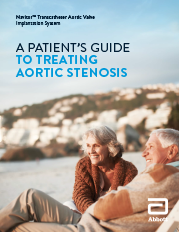AORTIC STENOSIS
What is
Aortic Stenosis?
Aortic stenosis is a serious and progressive heart valve disease. It is one of the most common heart valve diseases, affecting more than 20% of older people.1
If left untreated, aortic stenosis can lead to heart failure and death.1
Download the Aortic Stenosis Treatment Guide to learn more about aortic stenosis symptoms and a treatment option for severe aortic stenosis.
Aortic Stenosis is a narrowing
of the Aortic Valve
Your heart has four valves that direct blood flow between the chambers of the heart. These valves act like one-way doors, allowing blood to flow forward into the next chamber. The valves close to prevent backflow.
On the left side of the heart, blood flows through the left ventricle into the aorta—the main artery of the body—through the aortic valve. The aortic valve has three flaps of tissue, called leaflets, that open and close to ensure that blood flows in only one direction.
Aortic stenosis, or AS, occurs when the leaflets become thick or stiff, which causes a narrowing of the aortic valve. Because of this, the valve doesn’t open and close properly, which restricts the flow of blood out of the left ventricle into the aorta.1,2 This makes it harder for your heart to pump oxygen-rich blood to your body, which can affect your health.

- Healthy Aortic Valve vs. Aortic Stenosis

Normal

Mild-to-moderate aortic stenosis

Severe aortic stenosis
What causes
Aortic Stenosis?
Aortic stenosis most commonly occurs in people 65 and older as a result of scarring and calcium buildup on the valve leaflets. Scarring and calcium build up may be from a normal sign of aging or from prior chest radiation, it may also result from having rheumatic fever during childhood, which is now rare in the United States.1,3
Aortic stenosis may be present in young people due to a birth defect, the most common being a bicuspid aortic valve. This is where only two leaflets grow instead of the normal three.1,3
Aortic Stenosis
symptoms
Aortic stenosis symptoms may not be noticeable during the mild-to-moderate stages of the disease when blood flow is not significantly reduced. As damage to the leaflets worsens, the valve further narrows and blood flow is greatly reduced.1 Once the disease progresses to this severe stage, aortic stenosis symptoms may include1:

SHORTNESS OF BREATH

DIZZY

DIFFICULTY WALKING SHORT DISTANCES

DECLINE IN ACTIVITY LEVEL OR REDUCED ABILITY TO DO NORMAL ACTIVITIES

CHEST PAIN

RAPID, FLUTTERING HEARTBEAT

SWOLLEN FEET OR ANKLES

DIFFICULTY SLEEPING OR NEEDING TO SLEEP SITTING UP
The symptoms of aortic stenosis can be misunderstood as “normal” signs of aging—if you or a loved one experience any of these symptoms, see a doctor right away.
Patients diagnosed with mild-to-moderate aortic stenosis who have no symptoms should receive regular clinical and echocardiography exams to monitor the progression of their valve disease.4 Echocardiography is a test that uses sound waves to produce live images of your heart that allows your doctor to monitor how your heart and its valves are functioning.
Aortic Stenosis is
progressive and life threatening
If you are diagnosed with severe aortic stenosis, it is important to get treatment right away. Call your doctor as soon as you notice these symptoms or if your symptoms worsen.
Aortic stenosis is a progressive disease, which means that it will become more severe over time. As your leaflets become more damaged, the heart must work harder to pump blood through the narrowed valve opening. This causes the wall of the left ventricle to enlarge and thicken and the heart to weaken, reducing the amount of blood supplied to the body. In time, this may lead to heart failure and death.1,3
From the onset of symptoms, risk of death from severe aortic stenosis is as high as 25% at 1 year and 50% at 2 years in patients who do not undergo aortic valve replacement.5
AORTIC STENOSIS TREATMENT
If you or a loved one has been diagnosed with aortic stenosis, it’s important to seek timely treatment since the condition gets worse over time. Your doctor will discuss the best treatment option for you. Learn about aortic stenosis treatment options.
The information provided is not intended for medical diagnosis or treatment as a substitute for professional medical advice. Consult with a physician or qualified healthcare provider for appropriate medical advice.
MAT-2304819 v3.0 | Item approved for U.S. use only.
